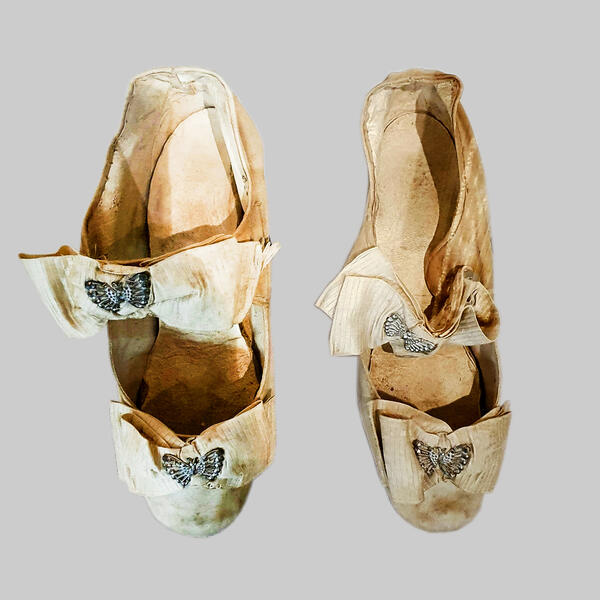This pair of Empire style women’s footwear has a touch of classical antiquity’s influence, as these shoes are low and flat, almost lacking the heel. Leather or velvet embroidered shoes
were intended for outside wear, while silk and satin ones were reserved for balls. Oftentimes, the toepiece had a square shape.
Approximately from 1800 to 1810, ballroom shoes had pointed, then round toes, and then, starting with the 1830s, the so-called “slightly square” toes came into fashion.
Other types of women’s shoes included ankle-high boots, walking shoes, and ballroom shoes (also known as slippers) for small, family- or village-wide balls. For large high-society balls, women wore silk, satin, or velvet shoes. In the 18th century, women’s footwear had rather high curved heels By the late 18th century, heels became shorter, while the toes of the shoes became pointed. And then the heels disappeared altogether, and women’s shoes began to resemble Ancient Greek sandals fitted with straps, which were usually criss-crossed.
Women’s footwear regained the heels in the second half of the 19th century, and by the end of the century, shoes began to look not very different from modern models.
As a cultural phenomenon, balls were exclusive to the European tradition. They were brought to Russia by Peter the Great, who ordered the arrangement of mandatory balls. Gradually, this innovation of the first Emperor of All Russia not only caught on, but became loved by many.
Of particular brilliance and splendor were the balls held during the reign of Catherine the Great. This was noted even by those who have witnessed the magnificence of Versailles.
During that time, balls in honor of certain persons or events began to be held even without government initiative. Provincial nobility arranged them in provincial assembly halls of the nobility. Especially famous were the balls held in the Moscow Assembly of the Nobility.
These events always followed a clear established procedure. In the early 19th century, precisely when women danced in shoes similar to these, balls always began with a polonaise. The dance was led by the owner of the house and the most honored female guest as the first pair, followed by the owner’s wife with the most honored male guest as the second pair.
Apart from dancing, balls, especially royal balls, combined the functions of receptions, celebrations, and grand meetings of guests and ambassadors. This type of formal events continued to exist up until the October Revolution. In the Soviet tradition, balls were replaced with various kinds of solemn gatherings and concerts.
Approximately from 1800 to 1810, ballroom shoes had pointed, then round toes, and then, starting with the 1830s, the so-called “slightly square” toes came into fashion.
Other types of women’s shoes included ankle-high boots, walking shoes, and ballroom shoes (also known as slippers) for small, family- or village-wide balls. For large high-society balls, women wore silk, satin, or velvet shoes. In the 18th century, women’s footwear had rather high curved heels By the late 18th century, heels became shorter, while the toes of the shoes became pointed. And then the heels disappeared altogether, and women’s shoes began to resemble Ancient Greek sandals fitted with straps, which were usually criss-crossed.
Women’s footwear regained the heels in the second half of the 19th century, and by the end of the century, shoes began to look not very different from modern models.
As a cultural phenomenon, balls were exclusive to the European tradition. They were brought to Russia by Peter the Great, who ordered the arrangement of mandatory balls. Gradually, this innovation of the first Emperor of All Russia not only caught on, but became loved by many.
Of particular brilliance and splendor were the balls held during the reign of Catherine the Great. This was noted even by those who have witnessed the magnificence of Versailles.
During that time, balls in honor of certain persons or events began to be held even without government initiative. Provincial nobility arranged them in provincial assembly halls of the nobility. Especially famous were the balls held in the Moscow Assembly of the Nobility.
These events always followed a clear established procedure. In the early 19th century, precisely when women danced in shoes similar to these, balls always began with a polonaise. The dance was led by the owner of the house and the most honored female guest as the first pair, followed by the owner’s wife with the most honored male guest as the second pair.
Apart from dancing, balls, especially royal balls, combined the functions of receptions, celebrations, and grand meetings of guests and ambassadors. This type of formal events continued to exist up until the October Revolution. In the Soviet tradition, balls were replaced with various kinds of solemn gatherings and concerts.


